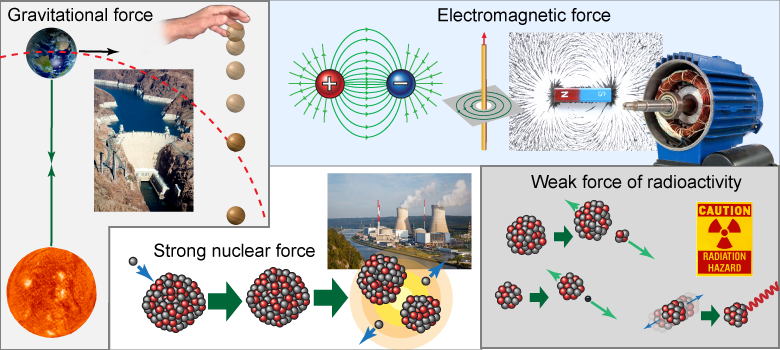|

|
In the standard model, there are four fundamental interactions of nature: the gravitational, electromagnetic, strong, and weak forces. Forces are often called “interactions” to emphasize how elementary particles are acting on each other. 
|
The gravitational force is an attractive force that acts between any two objects or particles that have mass. Gravity prevents you from floating away from the surface of the Earth, maintains the Earth in orbit around the Sun, and governs the orbit of the Sun in the Galaxy. The electromagnetic force acts in two different ways: Electrically charged objects or magnetic objects attract or repel each other. The electric and magnetic forces are two manifestations of one underlying phenomenon: electromagnetism. The gravitational and electromagnetic forces are part of “classical” physics, which was fairly well understood by the beginning of the 20th century. 
|
At the dawn of the 20th century, new physics was necessary to explain the atomic world. From the new physics two new forces emerged. The strong nuclear force acts only over very short distances at the scales found in and around the nucleus of an atom. The strong force is required to hold the nucleus together, because otherwise the electric force of repulsion between the protons would force them apart. The weak force governing radioactive decay is the fourth and final member of the fundamental forces of nature. Nuclear particles periodically undergo radioactive decay (such as alpha or beta decay); the weak force provides a framework for understanding radioactivity. The strong and weak forces comprise the new physics that arose in the quantum world of atoms and atomic nuclei. 
|
Together, these four forces provide a complete explanation for all the processes through which matter and light interact. In recent decades, theoretical physicists have tried to go one step further. Their theories unify two or more of these forces into a single underlying force, much in the same way that electricity and magnetism were unified. The new theories are called Grand Unified Theories, because they seek to unify different forces of nature under a common framework. Do you think that, in your lifetime, a model will successfully unify all four forces? 
 |
Abdus Salam, Sheldon Glashow, and Steven Weinberg proposed a model in which, at very high energies, the weak force and the electromagnetic force merge together into a single force, the electroweak interaction. Subsequent experimental studies of elementary particles confirmed the model by allowing observation of the scattering properties of neutrinos and by enabling two new particles, the W and Z bosons, to be discovered. At the very high energies found in particle accelerators, or soon after the Big Bang, nature had only three fundamental forces: gravity, the strong force, and the electroweak interaction. Will future physicists reduce the number of forces to two or one? 
|
Which of the four fundamental forces of nature holds the protons and neutrons in an atom together? - the gravitational force
- the electromagnetic force
- the strong nuclear force
- the weak nuclear force
 |
The correct answer is c, the strong nuclear force. The gravitational force deals with interactions between masses. The electromagnetic force deals with interactions between charged objects and electric and magnetic fields. The weak nuclear force deals with radioactive decay. 
|
| |
|

